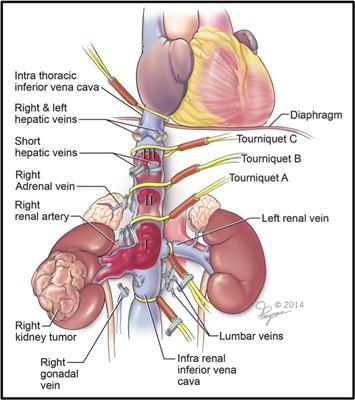Jul 30 2015
Surgery is required when cancer of the kidney causes a Level III thrombus, or clot, to develop in the major vein leading back to the heart. Traditionally this complicated procedure, inferior vena cava (IVC) thrombectomy, is performed using a large open incision, primarily because the vein is often difficult to reach.
 Inferior vena cava control for which individualized surgical planning is necessary. Note various locations of Rummel tourniquet placement for achieving proximal control of IVC as dictated by thrombus level (Mayo classification).
Inferior vena cava control for which individualized surgical planning is necessary. Note various locations of Rummel tourniquet placement for achieving proximal control of IVC as dictated by thrombus level (Mayo classification).
In an article published in The Journal of Urology®, a team of surgeons describe the first cases in which this procedure has been successfully performed robotically, using only seven small incisions and four robotic tools.
“Level III IVC tumor thrombectomy for renal cancer is one of the most challenging open urologic oncologic surgeries,” explained Inderbir S. Gill, MD, of the USC Institute of Urology, part of Keck Medicine of USC in Los Angeles, CA. “While IVC tumor thrombus occurs in only 4-10% of all patients with otherwise organ-confined kidney cancer, surgery is the only cure. The ability to do this complicated procedure in a minimally invasive way represents a major advancement.”
The authors report on nine patients with renal cancer and Level III thrombi treated with robotic IVC thrombectomy. After about seven months of follow-up, all have survived and eight show no evidence of disease. One patient had a spinal tumor and has since undergone further surgery.
This report also details seven additional robotic surgeries on patients with smaller thrombi (Level II), and compares tumor sizes, operating room times, blood losses, length of hospital stays, and other details for Level III and Level II cases.
Because the surgery involves removal of the thrombus as well as removal of the diseased kidney, the surgeon must remove the clot first to prevent it from breaking off and causing a potentially fatal embolism. This requires many blood vessels to be clamped as shown in the diagram. This diagram also indicates the extent of Levels I, II and III thrombi, and the relative sizes of the obstructions.
“All necessary surgical maneuvers could be performed completely robotically without open conversion or mortality. This demonstration of efficient robotic performance of the challenging vascular, oncologic and reconstructive procedures inherent herein opens the door for major renal, caval, and hepatic robotic surgeries in the future. Although our experience is yet initial, we believe that robotic IVC thrombus surgery has considerable potential for the future,” commented Dr. Gill and the team.